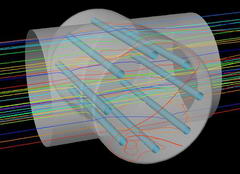|
《在测试布线系统时,愿望不等于质量保证》——实现认证测试和文档的标准将为用户建立起信心
对于布线施工人员来说,他们不希望接到用户的回叫电话等这样的突发事件。福禄克网络公司铜缆认证市场部的 Hugo Draye 在 Cabling Installation & Maintenance 杂志中这些写到,施工人员要做很多工作来确保用户的付出与所得成正比。这不再是以信息为基础,而是基于对不同的电缆施工所使用标准的理解,以及测试施工是否满足或超越这些标准所使用的测试工具。
[原文]
 Hope is not a warranty when testing a cabling system Hope is not a warranty when testing a cabling system
Certifying and documenting standards compliance will help you set users' minds at ease.
The installation of a cabling system represents a significant investment for a commercial enterprise, both in terms of the money spent and of its impact on the efficiency of the enterprise. For many corporations, the network has become a mission-critical element of the information technology infrastructure. Downtime can cause significant financial losses. The cabling system, therefore, should be viewed as the foundation of this critical resource. If the foundation is flawed or unreliable, the network operation is flawed and unreliable. As such, corporate buyers should insist on a substantive warranty.
A warranty reflects, on one hand, the manufacturer's confidence in the quality of its product. On the other hand, it provides protection to the buyer against defects in materials and workmanship. The use of the warranty program as a statement of the manufacturer's confidence made Lee Iaccoca, then chairman of Chrysler Corporation, famous. His expression of confidence, backed by the most aggressive warranty program in that industry at the time, communicated to potential car buyers reassurance when purchasing new Chrysler products. It may be argued that this bold move saved the company.
The two-party plan
The market also expects that the cabling manufacturer providing a better warranty program has implemented a higher degree of quality procedures in the design and manufacturing of its products. As consumers, we typically pay more attention to the details of a warranty program as the price of the item increases.
Two parties are involved in establishing a cabling infrastructure warranty: the manufacturers of the cable and connecting hardware, and the contractor who installs these components. They must cooperate to assure the quality of the final product. A common plan or agreement between these parties should involve:
- The component manufacturers' ability to deliver products that meet system performance and quality standards;
- The contractor/installer's responsibility for the quality and performance of a finished cabling installation.
The contractor also has the responsibility for providing technicians who are knowledgeable and well-trained in the practices to implement a cabling installation. The contractor should also provide tangible proof that every installed link delivers the desired performance.
Field testing essentials
Proper field test procedures will accomplish this requirement. Field testing the links' performance assures that all components meet the performance specifications, and that the workmanship of the final installation did not detract in a significant way from the transmission quality that can be achieved with the installed components.
This test must be performed on-site after the last cable is terminated and the last wall outlet is buttoned up. Premises wiring manufacturers that "underwrite" the warranty, as well as the representatives of the end-user customer or the consultant who represents the end user, should carefully review the test-result data of the completed installation.
Field-testing is critical to the warranty process. No automobile manufacturer would warrant their product without following well-defined production and test procedures. The same paradigm holds true for cabling installations.
Defining quality
The Telecommunications Industry Association's (TIA; www. tiaonline.org) TIA/EIA-568-B standard defines field-test procedures to ensure that the installed links meet a specified level of performance. Testing against performance standards is often called certification testing, and a meaningful warranty statement should be based on these results.

High-capacity storage and removable media, like this multimedia card, allow contactors to capture the voluminous test data that is essential to providing a meaningful warranty.
Standards define different categories or levels of performance. Category 3 is the lowest category suitable for lower-throughput data communication (up to 16 Mbits/sec). This category is also recommended for voice cabling. The next commonly used category, Category 5e, provides a 100-MHz communication channel. Category 6 delivers a 250-MHz communication channel and represents the highest performance level currently defined in the TIA standards. TIA committees, in cooperation with the Institute of Electrical and Electronics Engineers (IEEE; www.ieee.org), are now studying the transmission requirements for an Ethernet network implementation that delivers a 10-Gbit/sec transmission rate.
The International Standards Organization (ISO; www.iso.org), however, refers to Class C, D, E, and F for the installed link and uses the category designation for the component specifications. A twisted-pair cabling link constructed with Category 3 components should meet the performance specification of a Class C link. Class D links require that all components meet the Category 5e specification, and Class E corresponds to Category 6 components. The international standards also define a Class F link (specified for a bandwidth of 600 MHz) when Category 7 components are used.
Testing and compliance
ISO and TIA standards are closely harmonized and only subtle differences remain between them. The standards define two link models: the channel and the permanent link.The difference between the two is important.
The channel model is the end-to-end cabling link from an active device, such as an Ethernet hub or switch, to the network interface of a personal computer, printer, fax machine, or other networked device.

This screen of Fluke Networks' LinkWare Stats database program portrays the usefulness of electronically stored, sorted, and retrieved data.
The last segment of a channel link on either end is a patch cord, which may be changed relatively often over the life of a network, and is not considered part of the "permanent link" model. Therefore, the standards recommend that new installations be tested using the permanent link model.
The certification test tool connects to the permanent link under test using high-performance adapters that exclude any effects of patch cords. Performance test results describe the permanent link.
The channel test is available to troubleshoot an existing channel with patch cords that are in use. Patch cords have a significant impact on the channel's transmission characteristics, so the standards recommend to certify the performance of the permanent link and assure that good patch cords are used to connect the active devices.
The standards also define the performance parameters to be tested, the frequency range over which these parameters are to be tested, and the limits for the "pass" or "fail" performance at each frequency point.
This may sound complicated, but the appropriate test equipment can offer an automated way to certify with just a press of a single button. A tool with "autotest," for example, lets you select the cable type and test standard to apply, and then complete the test simply by pressing the "test" button. Newer testers perform an autotest for a Category 6 link, from 1 to 250 MHz, in as little as 12 seconds. Contractors can significantly reduce the total time-to-certify by using one of these newer certification test tools.
Certification is incomplete, and perhaps invalid, if properly executed test results are not documented. These results provide legitimacy to the warranty program and can be verified at any time. If documentation does not exist, the warranty may be virtually useless.
Detailing documentation
A quality certification tester provides several options to capture, store, and upload documented results. Data available in a protected database is much more useful than data that has been printed. Often, the contractor delivers a huge three-ring binder in which each page contains the results of a tested link. Thumbing through those binders can be painstakingly time-consuming. But with just a few mouse clicks, a test database program lets you view the graphical test results of any parameter of any link in the database.
The same industry standards referenced earlier also prescribe the documentation requirements and allow several options—from minimal documentation to capturing and storing every measurement. Everything in between these two extremes will be compliant with the standards.

Fluke Networks' DTX CableAnalyzer can perform a Category 6 autotest in 12 seconds, vastly reducing the time required to certify a cabling system.
Saving every data point in the test results record for a link requires approximately 18,500 measurement values for a Category 5e link and 30,000 for a single Category 6 link. Many certification testers on the market offer a removable memory card that let you store such large amounts of data.
If you are in a position to write the specifications for a cabling installation project, you should describe the test documentation you expect to receive. If you are a contractor and the statement of work for the job does not detail the test result requirements, you should request clarification before the testing phase commences, or choose the maximum (store every measurement). The Web site www.cabletesting.com contains a reference to assist in writing the statement of work for a cabling project's test and certification requirements.
Certification certainty
Since a cabling installation forms the foundation of the network, such an investment should not be made without requesting a solid warranty that the delivered product meets the specified requirements. Industry standards assist in formulating these requirements and offer a safe mechanism to futureproof the cabling infrastructure. Certification testing as specified in industry standards provides the assurance that all the components meet the required specification and that the workmanship with which the installation was completed will let the components perform as designed.
Documentation is an integral and necessary part of the certification tests. A warranty that is not based on proper certification testing, documented by electronically retrievable test results, only provides hope and not a solid assurance.
Download Minimum reporting requirements table as pdf. {pdf size: 90KB}
Hugo Draye is market segment manager of the Infrastructure Supervision Group at Fluke Networks (www.flukenetworks.com), where he manages product development and marketing of test equipment for structured cabling.
Cabling Installation & Maintenance August, 2004
Author(s) : Hugo Draye
|
